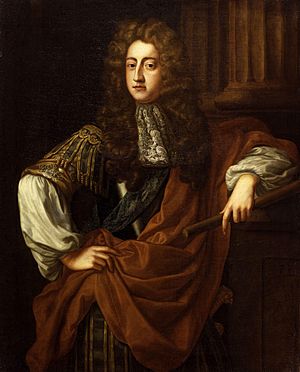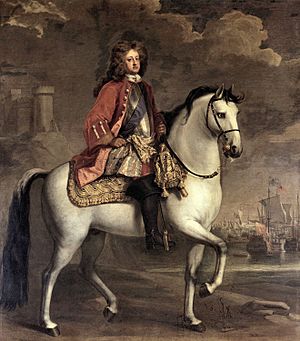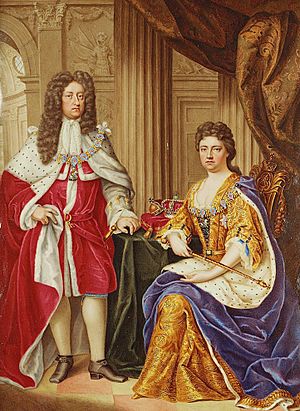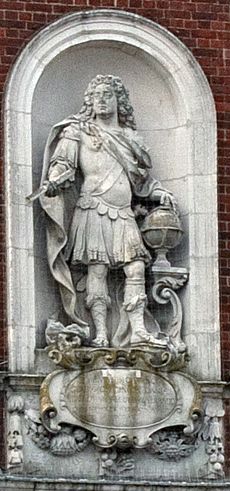Prince George of Denmark facts for kids
Quick facts for kids Prince George |
|
|---|---|
| Duke of Cumberland | |
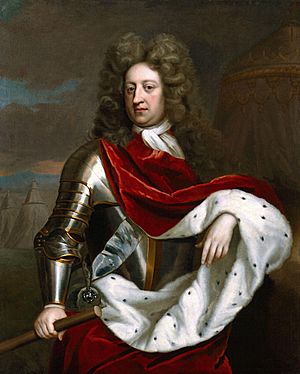
Portrait by Michael Dahl, c. 1705
|
|
| Consort of the British monarch | |
| Tenure | 8 March 1702 – 28 October 1708 |
| Born | 2 April 1653 Copenhagen Castle, Denmark–Norway |
| Died | 28 October 1708 (aged 55) Kensington Palace, London, England |
| Burial | 13 November 1708 Westminster Abbey |
| Spouse | |
| Issue more... |
Prince William, Duke of Gloucester |
| House | Oldenburg |
| Father | Frederick III of Denmark |
| Mother | Sophie Amalie of Brunswick-Lüneburg |
| Religion | Protestant (Lutheran) |
Prince George of Denmark (born Jørgen; 2 April 1653 – 28 October 1708) was the husband of Anne, Queen of Great Britain. He was the royal consort, meaning the husband of the queen, from when Anne became queen on 8 March 1702 until his death in 1708.
George and Anne's marriage was planned in the early 1680s. The idea was to create an alliance between England and Denmark. This alliance aimed to limit the power of the Dutch at sea. Because of this, George was not very popular with his Dutch brother-in-law, William III, Prince of Orange. William was married to Anne's older sister, Mary.
Anne and Mary's father, James II and VII, was the British ruler. He was removed from power in 1688 during an event called the Glorious Revolution. William and Mary then became joint rulers, with Anne next in line to the throne. The new rulers gave George the title of Duke of Cumberland.
William did not allow George to serve in the military. Neither George nor Anne had much power until Mary died, and then William died. After their deaths, Anne became queen. During his wife's rule, George sometimes used his influence to support her. He did this even when he privately disagreed with her. He was an easy-going person and was not very interested in politics. His appointment as Lord High Admiral of England in 1702 was mostly an honorary title.
Anne had many pregnancies with George, but sadly, most of their children did not survive. They had one son, Prince William, Duke of Gloucester, who lived to be eleven years old but was often ill. Despite the loss of their children, George and Anne had a very strong marriage. George died at age 55 from a long-term lung illness. Anne was heartbroken by his death. He was buried in Westminster Abbey.
Contents
Early Life and Royal Connections
George was born in Copenhagen Castle in Denmark. He was the younger son of Frederick III, who was the King of Denmark and Norway. His mother was Sophie Amalie of Brunswick-Lüneburg. From 1661, he had a governor named Otto Grote. George also received military training.
He traveled around Europe, which was common for royals at the time. He spent time in France and England in 1668–69. His father died in 1670 while George was in Italy. His older brother, Christian V, then became the King of Denmark.
In 1674, George was considered a candidate to become the King of Poland. He was supported by King Louis XIV of France. However, George was a strong Lutheran Protestant, which was a problem in Roman Catholic Poland. So, John Sobieski was chosen instead. In 1677, George fought bravely with his brother Christian in the Scanian War against Sweden. His brother was captured, and George bravely rescued him.
As a Protestant, George was seen as a good match for Lady Anne, who was the niece of King Charles II of England. They were distantly related. Both Denmark and Britain were Protestant countries. King Louis XIV of France wanted an alliance between England and Denmark to limit the power of the Dutch Republic. Anne's uncle, Laurence Hyde, 1st Earl of Rochester, and the English Secretary of State, Robert Spencer, 2nd Earl of Sunderland, secretly arranged the marriage. They wanted to keep the plans from the Dutch. Anne's father, James, Duke of York, liked the marriage. It reduced the influence of his other son-in-law, William III of Orange, who was Dutch.
Marriage and Family Life
George and Anne were married on 28 July 1683. The wedding took place in the Chapel Royal at St James's Palace in London. King Charles II and Queen Catherine were among the guests. Parliament gave Anne an allowance of £20,000 a year. George received £10,000 a year from his Danish lands. King Charles gave them a home in London called the Cockpit, near what is now Downing Street.
George was not very ambitious. He hoped to live a quiet life with his wife. He once wrote to a friend that he wished for "a quiet life somewhere."
Sadly, Anne had many difficult pregnancies. Within months of their marriage, she had a stillborn baby girl. Over the next few years, she gave birth to two daughters, Mary and Anne Sophia. In early 1687, George and his two young daughters caught smallpox. George recovered, but both his daughters died. Anne also had another miscarriage. It was a very sad time for them. A friend wrote that they were "very heavily" affected by the deaths. George returned to Denmark for a visit in mid-1687. Later that year, Anne gave birth to another child who did not survive.
In February 1685, King Charles II died without children. George's father-in-law, the Roman Catholic Duke of York, became King James II. George was appointed to the Privy Council. This meant he could attend important government meetings, but he had no power to change decisions.
Anne's older sister, Mary, had moved to the Netherlands. So, Protestants who opposed King James increasingly looked to Anne and George for leadership. The group around George and Anne was known as the "Cockpit Circle." On 5 November 1688, William of Orange invaded England. This event was called the "Glorious Revolution" and it eventually removed King James from power. George was warned about William's invasion. He told the Danish envoy that James's army was unhappy. George decided he would not serve under James. He left James's side on 24 November and joined William. King James reportedly said, "So 'Est-il possible' is gone too." George's decision to join William helped weaken the King's support. In December, James fled to France. The next year, William and Mary were declared joint monarchs, with Anne as the next in line to the throne.
Becoming Duke of Cumberland
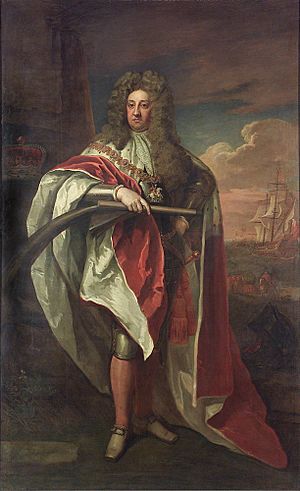
In April 1689, William agreed to make George an English subject. George was then given the titles of Duke of Cumberland, Earl of Kendal, and Baron of Okingham. He took his place in the House of Lords.
There was some mistrust between George and William. George had some financial claims related to land in Denmark. William agreed to pay him compensation, but George was not paid for a long time. During a military campaign in Ireland, George went with William's troops. He paid his own expenses, but he was not given a command. He was even refused permission to travel in William's coach. George tried to join the navy without rank, but William again stopped him. When William's Dutch guards did not salute George, Anne believed it was on purpose. George and Anne then left the royal court.
Things improved a bit after Queen Mary died suddenly from smallpox in 1694. This made Anne the direct heir to the throne. In 1699, William finally suggested that Parliament pay George the money he was owed. In early 1700, George received the payment.
By 1700, Anne had been pregnant many times. Sadly, most of her children were either miscarried, stillborn, or died very young. The only child who survived infancy was Prince William, Duke of Gloucester. He died in July 1700 at the age of 11. With Gloucester's death, Anne was the only person left in the line of succession. To make sure there would always be a Protestant ruler, Parliament passed the Act of Settlement 1701. This law named William and Anne's closest Protestant relatives, the House of Hanover, as the next in line after Anne.
George did not have a major role in government until his wife Anne became queen after William's death in 1702. George was the chief mourner at William's funeral. Anne made him general of all English military forces. She also made him Lord High Admiral, which was the official head of the Royal Navy. However, the real power at the Admiralty was held by George Churchill. Churchill's older brother, John Churchill, 1st Duke of Marlborough, was a close friend of Anne's and the leader of the English land forces.
Anne managed to get Parliament to grant George an allowance of £100,000 a year if she died before him. This bill passed easily in the House of Commons. However, it only just passed in the House of Lords. Marlborough supported the bill. Anne wanted Parliament to make George "King Consort," but Marlborough advised her not to.
During Anne's reign, she and George usually spent winters in London at Kensington and St James's Palaces. They spent summers at Windsor Castle or Hampton Court Palace, where the air was cleaner. George had recurring asthma, and the fresh country air helped him breathe better. They sometimes visited Newmarket, Suffolk, to watch horse races. Anne once bought George a horse for a very large sum of money.
In 1702, a bill called the Occasional Conformity Bill was introduced in Parliament. This bill aimed to prevent Protestant Dissenters from holding public office. The existing law allowed nonconformists to hold office if they took Anglican communion once a year. Anne supported this bill. She even made George vote for it in the House of Lords, even though he was a practicing Lutheran and an "occasional conformist" himself. As he voted, he reportedly told an opponent, "My heart is vid you." The bill did not pass. The next year, it was brought up again, but Anne did not support it. She feared it was meant to cause arguments between the two main political groups, the Tories and the Whigs. George never became a member of the Church of England, which his wife headed. He remained Lutheran and had his own personal chapel.
In the early years of Anne's reign, the Whigs gained more power. George used his influence in coastal towns to support Whig candidates in the 1705 election. He even told his secretary, George Clarke, who was a Member of Parliament, to vote for a Whig candidate for Speaker of the House of Commons. Clarke refused and supported the Tory candidate. As a result, Clarke was fired.
Later Years and Passing
In March and April 1706, George became very ill. He seemed to recover, but he was too sick to attend a special church service in June. He also missed another service in May 1707.
A major naval disaster in 1707, where a fleet was lost, showed problems at the Admiralty. George was officially in charge, but the real power was with Admiral Churchill. There was growing pressure to replace Churchill. By October 1708, a group of powerful politicians, known as the Whig Junto, wanted both Prince George and Churchill removed.
While these political pressures were happening, George was very ill. He suffered from severe asthma and dropsy (swelling caused by fluid buildup). He died at 1:30 p.m. on 28 October 1708 at Kensington Palace. The Queen was completely heartbroken. Anne wrote to her nephew, Frederick IV of Denmark, that "the loss of such a husband, who loved me so dearly and so devotedly, is too crushing for me to be able to bear it as I ought." Anne wanted to stay with her husband's body at Kensington. But under pressure from the Duchess of Marlborough, she reluctantly moved to St James's Palace. Anne was upset by the Duchess's actions, which included removing a portrait of George from the Queen's bedroom. Anne and the Duchess had been very close friends, but their friendship had become difficult due to political differences. George's death made their relationship even worse. He was buried privately at midnight on 13 November in Westminster Abbey.
Prince George's Legacy
After George's death, Anne at first refused to appoint a new Lord High Admiral. She insisted on doing the duties herself. She cried the first time she had to sign papers in George's place. However, the Whig Junto demanded that Lord Orford, one of George's critics, be appointed. Admiral Churchill retired. Anne appointed a moderate Tory, Lord Pembroke, to lead the Admiralty instead of a Whig. However, two Whig leaders were appointed to the Cabinet. The Whigs were still not happy and continued to pressure Pembroke and the Queen. Pembroke resigned after less than a year. After more arguments, Anne finally agreed to put Orford in charge of the Admiralty in November 1709.
His Character and Role
Prince George was known for being quiet and modest. Some people made fun of his asthma. By the time of Queen Victoria, George was often seen as a boring person. Victoria hoped her own husband, Prince Albert, would never be like the "very stupid and insignificant husband of Queen Anne." In the 1930s, Winston Churchill said George "mattered very little," except to Anne.

He did not have a big impact on how the navy was run. However, he was interested in navigation and the well-being of sailors. He supported the publication of John Flamsteed's Observations in 1704. He was not one of the most exciting political figures of his time. He was happy to spend his time building model ships. But he was a very loyal and supportive husband to Queen Anne. Their marriage was loving and faithful, even though they faced many personal tragedies.
The previous husband of a British queen, William of Orange, had become king. He refused to take a lower rank than his wife, Mary. William and Mary showed the traditional roles of the 17th century: Mary was the dutiful wife, and William held the power. George and Anne, however, reversed these roles. George was the dutiful husband, and Anne held the royal power. William had wrongly thought that George would use his marriage to Anne to gain power in Britain. But George never challenged his wife's authority and never tried to gain more influence.
Anne sometimes used the idea of being a dutiful wife to get out of difficult situations. She would claim that, as a woman, she knew "nothing except what the prince tells me." But this was just a trick. Husbands had a legal right to their wife's property. Some argued that it was unnatural for a man to be under his wife's authority. George made no such claims. He was happy to remain a prince and duke. He said, "I am her Majesty's subject, I shall do naught but what she commands me." According to historian Anne Somerset, the fact that Prince George was seen as unimportant actually helped people accept his unusual position. In a way, George helped advance the idea of women in power.
The Prince of Denmark's March by Jeremiah Clarke was written in his honor. Prince George's County, Maryland, was named after him in 1696.
Images for kids
See also
 In Spanish: Jorge de Dinamarca para niños
In Spanish: Jorge de Dinamarca para niños


